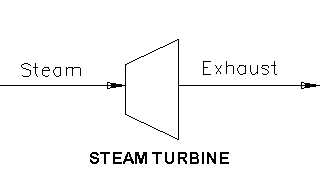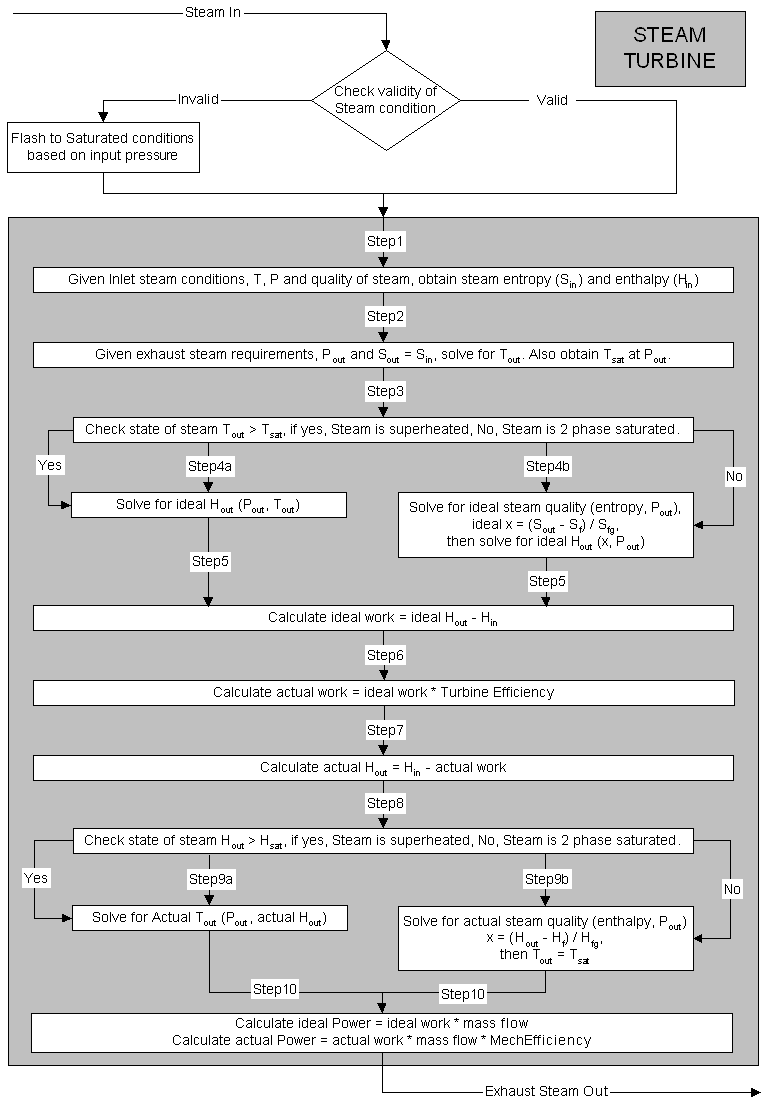Steam Turbine
Navigation: Models ➔ Energy Transfer Models ➔ Steam Turbine
General Description
The steam turbine converts steam energy into shaft work, which then can be converted to electrical work through the generator.
The configuration of the Steam turbine is very simple; the user needs only supply the required exhaust pressure and the Turbine isentropic efficiency.
The conditions of the steam inlet to the turbine is very important to the operation of the Steam Turbine. This includes the Temperature, pressure, mass flow and quality of steam. This information is normally specified in the Steam Feeder.
From the information provided, SysCAD will calculate the exhaust steam temperature, quality and the amount of power that can be generated from the steam.
Diagram
The diagram shows the default drawing of the Steam Turbine, with the required connecting streams. The Steam Turbine expects the inlet to be Steam, the valid conditions are: 2 phase saturated wet steam, pure saturated steam or superheated steam. The outlet from the turbine is the Exhaust steam and generated power.
Inputs and Outputs
| Label | Required Optional |
Input Output |
Number of Connections | Description | |
| Min | Max | ||||
| Steam | 1 Required | In | 1 | 1 | The steam inlet. |
| Exhaust | Required | Out | 1 | 1 | The exhaust steam. |
Behaviour when Model is OFF
If the user disables the unit, by un-ticking the On tick box, then the following actions occur:
- The product stream will be identical to the feed stream, i.e. the steam will not change temperature or pressure through the unit.
So basically, the unit will be 'bypassed' without the user having to change any connections.
Model theory
From the first law of thermodynamics, the energy balance is obtained by:
[math]\displaystyle{ \mathbf{\mathit{\boldsymbol{\Delta}E=-\boldsymbol{\Delta}[(H+K+P)m]+Q-W}} }[/math]
Assumptions
- The process is in steady state, thus dE = 0.
- A turbine can have heat transfer out through the casing, but typically they are well insulated so that the heat loss is small and given that the mass flow rate is large, the heat transfer per unit mass is almost nothing and thus is ignored. Thus Q = 0.
- The height difference between the inlet and outlet is negligible in terms of potential energy and this term is ignored. Thus, P = 0
- There may be some velocity effects (kinetic energy) if the exit velocity is very high. This is usually not known or measured and is implicitly included in the turbine efficiency - this term is ignored. Thus, K = 0.
- There is no loss of mass. Thus, mass in = mass out.
Calculating Work
From the above assumptions, the simplified energy balance is:
[math]\displaystyle{ \mathbf{\mathit{Work=Enthalpy_{in}-Enthalpy_{out}}} }[/math]
The analysis of turbine performance starts with the ideal turbine. The ideal work is what a turbine could produce when expanding steam from given initial conditions to a given final pressure with 100% efficiency. Thus step 1 of the calculation is:
(1) Calculate the ideal work output - an ideal turbine is isentropic so that exit entropy equals inlet entropy - the exit steam conditions and work is obtained from this.
The actual work is determined from the turbine efficiency (also known as the isentropic or adiabatic efficiency), which is simply a measure of how well the turbine is doing compared to a perfect machine operating under the same conditions. Thus step 2 of the calculation is:
(2) Actual work = ideal work * turbine efficiency.
The actual enthalpy out can be calculated from the actual work done, such step 3 is:
(3) Actual enthalpy out = enthalpy in - Actual work
From the actual enthalpy out and the specified required pressure of the exhaust, the actual temperature out and the quality of the steam can be calculated.
Calculating Power
[math]\displaystyle{ \mathbf{\mathit{Power = Actual work * mass flow * Generator Efficiency (MechEfficiency)}} }[/math]
Checking of Steam conditions
During the work calculations, checking of steam quality is important since the exhaust may have some condensation in it if enough energy is extracted from it. (Generally this is never more than a few percent in real turbines because water droplets moving close to the speed of sound can have a terrible erosive power which can damage the last few blade rows very quickly).
Typically, there are four cases of steam conditions that can exist in the turbine calculation:
| CASE | INLET STEAM | IDEAL EXHAUST | ACTUAL EXHAUST |
| (1) | superheated | superheated | Superheated |
| (2) | superheated | saturated | Superheated |
| (3) | superheated | saturated | Saturated |
| (4) | saturated | saturated | Saturated |
NB: saturated inlet means saturated exhaust.
In the case where the steam has some condensate in it - i.e. wet steam or the quality (x) is less than 100%, the calculations gets slightly lengthier.
For a detailed step-by-step calculation routine, please see section under Flowchart.
Flowchart
The following shows the steps in determining quality and condition of the exhaust steam, as well as the calculation of power generated.
Data Sections
The default access window consists of three sections:
- Turbine tab - This first tab contains general information relating to the unit.
- Info tab - Contains general settings for the unit and allows the user to include documentation about the unit and create Hyperlinks to external documents.
- Links tab, contains a summary table for all the input and output streams.
- Audit tab - Contains summary information required for Mass and Energy balance. See Model Examples for enthalpy calculation Examples.
Turbine Page
Unit Type: Turbine - The first tab page in the access window will have this name.
| Tag (Long/Short) | Input / Calc | Description/Calculated Variables / Options |
| Tag | Display | This name tag may be modified with the change tag option. |
| Condition | Display | OK if no errors/warnings, otherwise lists errors/warnings. |
| ConditionCount | Display | The current number of errors/warnings. If condition is OK, returns 0. |
| GeneralDescription / GenDesc | Display | This is an automatically generated description for the unit. If the user has entered text in the 'EqpDesc' field on the Info tab (see below), this will be displayed here. If this field is blank, then SysCAD will display the UnitType or SubClass. |
Requirements | ||
| On | Tick Box | If this option is switched off, then the turbine will behave like a pipe model. Thus, inlet conditions = outlet conditions. |
| PressureReqd / P_Reqd | Input | The required exhaust steam pressure. |
| Efficiency | Input | The required isentropic or adiabatic turbine efficiency. |
| MechEfficiency | Input | The required efficiency of the power generator. |
| TrackSteamFd | Tick Box | If this option is selected, then the feed steam quality will be checked. If the steam quality is less that that specified in the TrackSteamFrac field, a warning NOTE will be given in the condition field in the current access window. |
| TrackSteamFrac | Input | The minimum steam fraction expected in the feed stream. See above. |
Results | ||
| MassFlow / Qm | Calc | The mass flow of steam |
| TemperatureIn / Ti | Calc | The inlet steam temperature. |
| TemperatureOut / To | Calc | The exhaust steam temperature. |
| PressureIn / Pi | Calc | The inlet steam Pressure. |
| PressureOut / Po | Calc | The exhaust steam Pressure. |
| VapourFracIn / Vfi | Calc | The inlet steam quality (vapour fraction). |
| VapourFracOut / Vfo | Calc | The exhaust steam quality (vapour fraction). |
| SatT | Calc | The exhaust steam saturation temperature (at Pressure). |
| SatP | Calc | The exhaust steam saturation pressure (at temperature). |
| IdealWork | Calc | The ideal work = ideal enthalpy of exhaust - enthalpy of inlet steam. |
| TurbineWork | Calc | The Turbine work = ideal work * turbine efficiency. |
| WorkOut / Work | Calc | The actual work = Turbine work * MechEfficiency |
| IdealPower | Calc | The ideal power = ideal work * mass flow. |
| TurbinePower | Calc | The Turbine Power = ideal power * turbine efficiency. |
| PowerOut / Power | Calc | The actual power = Turbine Power * MechEfficiency. |
| H2O_Frac | Calc | The stream steam/water fraction. Thus, has the stream any impurities. |
| ExhaustMode | Display | The exhaust steam quality, valid options are: Superheated, two phases saturated or off (when turbine is switched off). |
Warnings and Errors
| Message | Explanation |
| Expect pure steam in feed | 100% Vapour expected in Feed. Set Track feed allowable liquid fraction higher. |
| Cannot achieve Pressure Requirements based on feed P | |
| Error Converging | |
| Invalid feed conditions. Try flash incoming stream | Incoming stream is not in equilibrium - most likely it has liquid in it and is below saturation pressure. Try turning on VLE in the feed pipe. |
| Cannot achieve Pressure Requirements based on feed T |
Adding this Model to a Project
Add to Configuration File
Sort either by DLL or Group:
| DLL: | HeatExchange.dll |
→ | Units/Links | → | Heat Transfer: Steam Turbine | |
| or | Group: | Energy Transfer |
→ | Units/Links | → | Heat Transfer: Steam Turbine |
See Model Selection for more information on adding models to the configuration file.
Insert into Project Flowsheet
| Insert Unit | → | Heat Transfer | → | Steam Turbine |
See Insert Unit for general information on inserting units.
Hints and Comments
- The steam turbine has a single extraction pressure, for modelling work of turbines with multiple extraction pressure sections; a number of turbines can be drawn in parallel with a steam feed splitter to simulate the process.
- Always double check if the steam feed conditions are valid. Use the VLE option in the Feeder-Cross Page Connector to add in a level of checking.
- If steam feed is not valid, then SysCAD will try and flash the feed stream to its saturated conditions (based on the inlet pressure.) This will change the feed stream temperature, as the flashing of the mixture will cool down the stream, while trying to keep its enthalpy constant.

